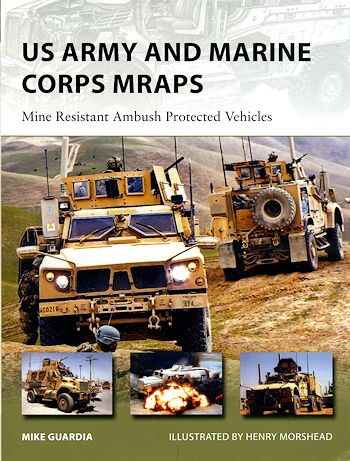 This
next title in Osprey's New Vanguard series is on vehicles developed for use in
the wars in Iraq and Afghanistan. These are some of the latest combat vehicles
operated by the US Army and US Marine Corps, and after the US leaves these
countries, they will probably not be used again.
This
next title in Osprey's New Vanguard series is on vehicles developed for use in
the wars in Iraq and Afghanistan. These are some of the latest combat vehicles
operated by the US Army and US Marine Corps, and after the US leaves these
countries, they will probably not be used again.
You see, these are specially designed and very expensive vehicles called
MRAPS (Mine Resistant, Ambush Protected vehicles). There sole purpose is to keep
the occupants from being blown to pieces by mines and IEDs ( Improvised
Explosive Devices). These are the weapons of choice in both areas of combat
because they have been so successful. The insurgents can easily make these
weapons and they can be detonated by something as simple as a cell phone. Not
only that, but once they are discovered and removed, replacements can be put
somewhere else in practically no time.
Since a lot of troops were being killed by these, and current vehicles (uparmored
HMMVs) were not providing the protection that was needed, it was decided that a
dedicated vehicle was needed. There are several classes of vehicle all based on
their weight and carrying capability. All of them are ridiculously expensive,
which is typical for the gravy train that is military weapons procurement.
Interestingly, these are not the first vehicles of their type. The
original mine resistant vehicles were developed in South Africa during the late
20th Century when that nation was undergoing the throes of violent revolt. What
all these vehicles have in common is a vee shaped lower body. This allows the
blast to be deflected outward from the vehicle. The result is that the majority
of the explosion is not directly against the vehicle and its occupants, allowing
the crew and riders to escape death.
Several companies designed vehicles to meet the standards set down by
the US Army. Some of them were successful and resulted in orders while others
were not. All of these vehicles are included in this book. Not only were the
vehicles required, but new tactics in using them had to be developed as well.
All of this is in this very well done and well researched book. The result is
that more troops are alive today because of the design features of these
vehicles. The interesting thing is that with the withdralw of foreign forces
from these nations, the need for these vehicles seems to have gone away and no
others are being developed for future use.
In all, this is a very interesting book on these seemingly 'dead end'
vehicles and one that will appeal to the enthusiast and modeler alike.
Highly recommended reading.
January 2014
For more on the complete line of Osprey books,
visit www.ospreypublishing.com. In the US, it is
Osprey Direct at 44-02 23rd St, Suite 219, Long Island City, NY 11101., where you can
get a catalogue of available books.
If you would like your product reviewed fairly and
fairly quickly, please
contact
the editor or see other details in the
Note to
Contributors.
 This
next title in Osprey's New Vanguard series is on vehicles developed for use in
the wars in Iraq and Afghanistan. These are some of the latest combat vehicles
operated by the US Army and US Marine Corps, and after the US leaves these
countries, they will probably not be used again.
This
next title in Osprey's New Vanguard series is on vehicles developed for use in
the wars in Iraq and Afghanistan. These are some of the latest combat vehicles
operated by the US Army and US Marine Corps, and after the US leaves these
countries, they will probably not be used again.